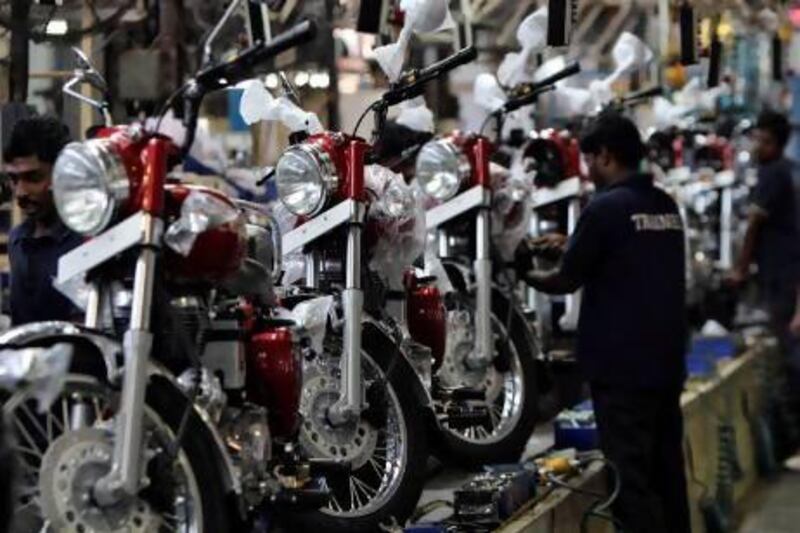Growth in India's motorcycle market may have slowed down, but for one historic brand sales are revving up.
Royal Enfield has recently managed to turn its business around having once been on the brink of collapse, analysts say.
Although Royal Enfield was originally British, its Indian division outlived the UK company and took over the name about 20 years ago.
Despite its long history in India, the company has only a very small share of the market and for about two decades up until recently it did not experience significant growth, according to the company. But sales have surged in the past couple of years.
Royal Enfield sold 112,000 motorcycles last year compared to 76,000 in 2011, a growth of 47 per cent, according to figures from Eicher, the manufacturer of Royal Enfield in India. In the first quarter of this year, Royal Enfield sold 34,736 motorbikes compared with 23,899 in the same period last year, an increase of 45.3 per cent.
"Royal Enfield has bucked the trend," the company says. "In fact when the two-wheeler segment was growing in India, Royal Enfield was far behind. Now when the two-wheeler market has slowed down, Royal Enfield has been growing in leaps and bounds."
Its bikes cost between 100,000 rupees (Dh6,498) and 190,000 rupees.
"This was a company that was almost literally shutting down shop before Eicher took over," says Sanket Maheshwari, the assistant vice president at ICICI Securities. "I don't think [the growth] is anything to do with industry dynamics. I think it's more to do with what Enfield has started doing over the last two or three years. It took maybe seven or eight years to turn things around.
"Historically, there used to be product-related issues which customers used to have with Royal Enfield bikes," he says. "It wasn't really upgrading and launching new products quickly. On the other hand, in the last two to three years, they have increased the quality of the products dramatically. The kind of faults which we used to observe in Royal Enfield bikes five or six years ago, they have reduced significantly."
Total motorcycle sales in India, including scooters, grew by just 1 per cent in April, according to data from the Society of Indian Automobile Manufacturers, amid a slowing economy and high fuel prices.
"If you look at Eicher's Royal Enfield Bullet, for example, these are typically targeted at customers who love biking," says Mr Maheshwari. "Therefore, the target audience is normally an urban customer who is buying a bike because of his hobby. He doesn't use it for conventional means. This kind of target audience has not been impacted at all. Normally in India, a bike is used for normal transport and in that sense it is a necessity also. Royal Enfield in fact has a capacity constraint because of which they cannot really grow as much as they could. They have a waiting list of about six to eight months."
Royal Enfield exports its motorcycles to more than 40 countries, including the UAE, United States, Japan, Bahrain, United Kingdom, France, Germany, and Argentina, although its export numbers make up a very tiny proportion of it sales. It says it now plans to ramp up shipments, with a push into Latin America and South East Asia.
"Globally, a midsized motorcycle is from 250cc to 650cc," Eicher said. "Our target is to become the number one midsized motorcycle [manufacturer] in the world. That is our next level of growth as we feel that we are on the right track in India."
Mitul Shah, an auto analyst at Karvy Stock Broking, pointed out that although the motorcycle industry had slowed in recent months, it still had significant growth potential in the long term.
"With the rising per capita income and relatively poor infrastructure, the two-wheeler industry has been growing in India and has proved to be one of the most comfortable transportation mediums in India," Mr Shah said. "Slowly, we believe that Royal Enfield can keep gaining market share."
Royal Enfield was founded in the UK in Redditch, Worcestershire, where the Enfield Cycle Company made motorcycles, bicycles, and lawnmowers under the name, launching its first motorcycle in 1909. It began selling motorcycles in India in 1949.
"In 1955, the Indian government started looking for a suitable motorcycle for its police forces and the army for patrolling duties on the country's border," according to Royal Enfield's website. "The Bullet 350 was chosen as the most suitable bike for the job. The Indian government ordered 800 of these … [and] thus in 1955, the Redditch company partnered with Madras Motors in India to form what was called Enfield India."
UK production ceased in 1970 and the following year the company was dissolved.
But production of the Bullet 350 continued in India, with vehicles even being exported to Europe.
The automotive group Eichermerged with Enfield India in 1994 and changed the name of the company to Royal Enfield.
The Indian company recently opened a second plant near Chennai, in the town of Oragadam, to increase production.
"With the speedy execution of the first phase of the plan, we will now have a capacity of 175,000 motorcycles in 2013, from both plants," Eicher said. "We have already begun working on the second phase of expansion at Oragadam, which will further increase the production capacity to 250,000 motorcycles in 2014."





